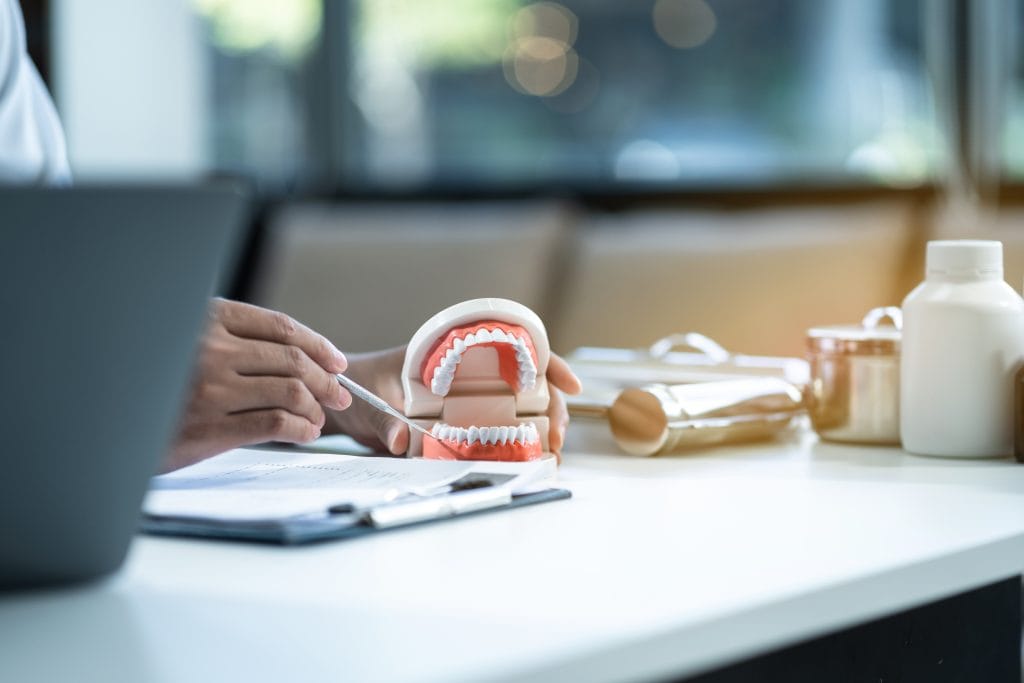Last updated on November 27th, 2025 at 02:56 pm
Last updated on November 19th, 2025 at 11:22 pm
Last updated on October 30th, 2025 at 06:35 pm

Presenting full mouth implant cases can feel daunting—not just for the dentist, but also for the patient. With treatment plans ranging anywhere from $15,000 to $60,000, these are not quick or casual decisions. Success depends on creating the right environment, communicating effectively, and guiding patients through a process where they can see the value and make a confident choice.
Beyond the technical aspects of treatment planning, these conversations are about helping patients face a major life decision. Many of them have been struggling with their dental health for years, and this is the moment where they decide what kind of future they want for themselves. That’s why your role isn’t just as a clinician—it’s also as a guide, a teacher, and someone who can connect their medical needs to their personal goals.
Set Aside the Time
These cases should never be rushed. They require dedicated consultation time where you can sit down with the patient, walk them through their options, and answer their questions thoroughly. A follow-up consultation is often necessary.
If you attempt to squeeze a presentation like this into a packed schedule, you’ll likely miss the chance to build trust and address their concerns. Patients can sense when they’re being rushed, and given the financial and emotional weight of these cases, that can cost you the acceptance of treatment. Investing the time upfront saves everyone frustration later.
Align With the Patient’s Goals

The most effective way to present any case—especially one of this magnitude—is to work with the patient, not against them. That starts with understanding their goals. Ask them:
- Do they want to try to keep their remaining teeth?
- Are they ready to transition to dentures?
- Do they want a solution that feels and functions like natural teeth?
When you can align your recommendations with what matters most to them, the conversation becomes collaborative instead of confrontational. This also ensures the patient feels heard, which goes a long way in building rapport.
Help Them Confront the Decision
Patients at this stage are at a crossroads: either continue with failing teeth, accept dentures, or move forward with implants. It’s important to help them truly consider what life with dentures means compared to having stable, functional teeth. This isn’t just about health—it’s about quality of life. The ability to eat comfortably, enjoy dinners with friends, and socialize without worry is priceless.
Remind them that everyone reaches this point sooner or later. Their teeth have served them well, but now a decision must be made. Framing it this way makes the choice clear and allows you to guide them through what’s best for their future.
Don’t Lead With Money

Avoid making finances the first topic. Instead, help the patient decide that implants are the right choice for them. When someone really wants something, they’ll usually find a way to afford it. If they don’t want it, no amount of financing options will remove their barriers.
Once they’ve committed, present flexible financial pathways. Larger cases often require piecing together solutions from multiple lenders—CareCredit, Proceed, Lending Club, Cherry, etc.—each with different rates and terms. Having a wide range of financing options ensures you can tailor solutions to individual needs and credit situations.
Patients also appreciate transparency. Explain the pros and cons of each option and be upfront about what their monthly commitments might look like. When you work side by side to find a solution, they feel empowered rather than pressured.
Educate, Don’t Convince
Your role as a doctor goes beyond diagnosis. The Latin root of “doctor” actually means teacher. Educate your patients so they see the situation the same way you do. When they fully understand the importance of treatment, you won’t need to “sell” them—they’ll arrive at the decision themselves.
This is where strong communication skills come into play. Use simple analogies to explain complex procedures. Relating implants to something familiar, like comparing their investment to the cost of a new car, can help patients put the value in perspective. And always circle back to their personal goals—remind them how this decision will improve their health, confidence, and day-to-day life.
Communication and Tools Matter

These conversations are as much about communication as they are about clinical expertise. Work on your ability to explain clearly, connect personally, and guide patients with confidence. Visuals can also be powerful—videos, before-and-after photos, or digital mockups make the treatment real and relatable.
Pre-qualifying patients financially can be helpful, but never make assumptions about what they can or can’t afford. Instead, focus on making the case compelling, and then provide the financial pathways. By combining clear communication with supportive visuals, you help patients envision themselves with their new smile—and that vision is often what inspires them to move forward.
Final Thought
Presenting full mouth implant cases is not about pushing patients into a decision—it’s about helping them make the right one. With time, alignment, education, and communication, you can guide them toward the solution that restores not only their smile, but also their confidence and quality of life.
Remember: the more you invest in refining your communication and case presentation skills, the more comfortable patients will feel. When they see you as a trusted advisor rather than a salesperson, they’re far more likely to accept the treatment that will change their lives for the better.
For any additional questions, give us a call at (800) 640-1140 or visit https://www.mgeonline.com/



No Comments
Be the first to start a conversation